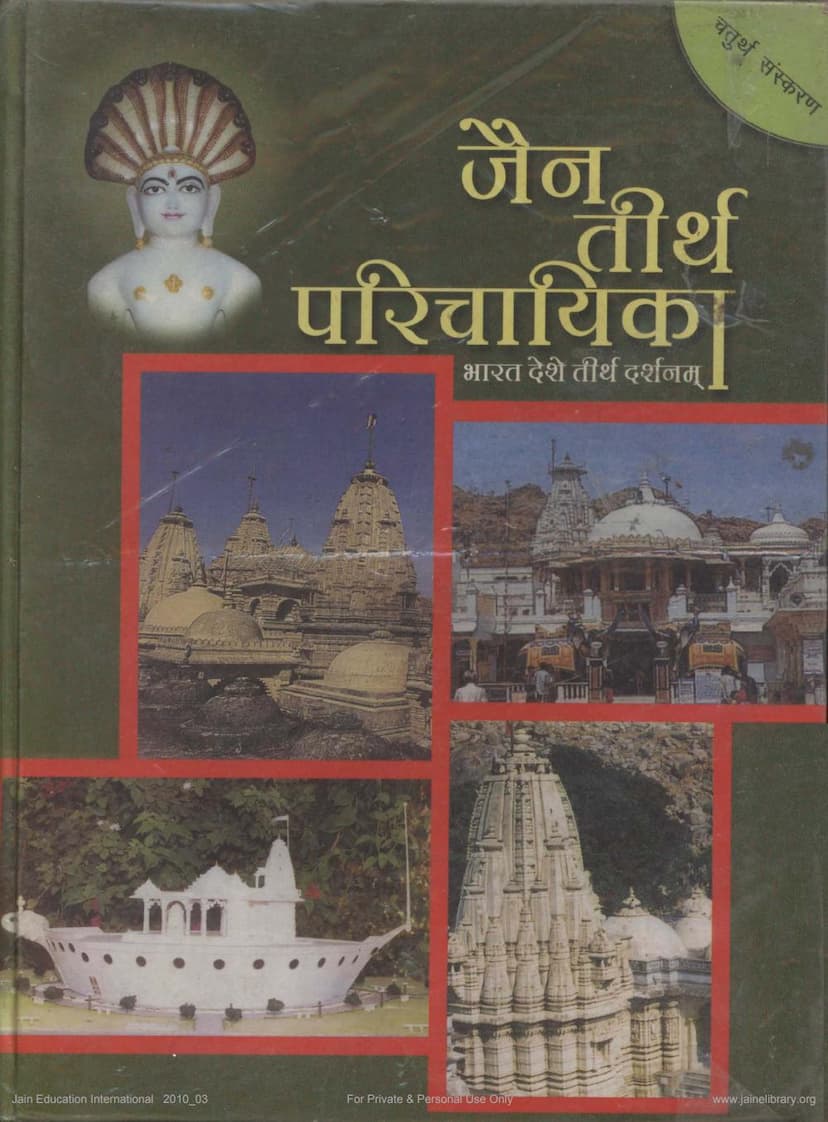Jain Tirth Parichayika
Added to library: September 2, 2025

Summary
This is a comprehensive summary of the Jain text "Jain Tirth Parichayika" by Shreechand Surana, published by Diwakar Prakashan:
Book Title: Jain Tirth Parichayika (A Guidebook to Jain Holy Places) Author: Shreechand Surana Publisher: Diwakar Prakashan Edition: Fourth Edition (January 2004)
Overall Purpose: The "Jain Tirth Parichayika" is a meticulously revised and updated guide to Jain pilgrimage sites across India. Its primary aim is to provide comprehensive information for Jain pilgrims, enabling them to plan and undertake their journeys smoothly and fulfilling. The book acts as a directory, a roadmap, and a source of essential details for each Tirth.
Key Features and Content:
-
Definition of Tirth: The book begins by defining a "Tirth" according to Jain philosophy, encompassing both mobile (Jangam) and stationary (Sthavar) holy places. It highlights Tirthankaras, saints, and devout followers as living "Jangam Tirths," and places of spiritual significance like "Siddh Kshetra" (places of liberation), "Atishay Kshetra" (places blessed by Tirthankaras), and "Prabhavak Kshetra" (places of spiritual influence) as "Sthavar Tirths."
-
Geographical Organization: The Tirths are systematically organized by state and then by district. Within districts, the arrangement follows the alphabetical order of the English names of the districts. This structure allows for easy navigation and reference.
-
Detailed Information for Each Tirth: For each Tirth (holy place) described, the book provides:
- Mulnayak (Main Deity): Information about the principal idol, often mentioning the Tirthankara, the material, and the posture (e.g., Padmasanasth, Khadgasana).
- Location and Guidance: Detailed directions on how to reach the Tirth, including nearby railway stations, road distances, bus services, and travel options from major cities.
- Historical and Spiritual Significance: Information about the Tirth's history, its connection to specific Tirthankaras (birthplace, places of enlightenment, Nirvana), legends, miracles associated with the place, and the significance of festivals or melas held there.
- Temple Architecture and Art: Descriptions of the architectural styles, artistic carvings, sculptures, and unique features of the temples.
- Accommodation and Facilities: Information about available Dharamshalas (pilgrim rest houses), hotels, dining facilities (Bhojanshala), and other amenities for pilgrims.
- Nearby Attractions: Mentions of other significant places or tourist spots in the vicinity of the Tirth.
- Contact Information: Addresses and sometimes phone numbers for the managing trusts or committees (Pedhi) of the Tirths.
-
Comprehensive Coverage: The book covers a vast number of Jain Tirths spread across various states of India, including:
- Punjab, Himachal Pradesh, Jammu & Kashmir
- Delhi & Uttar Pradesh
- Bihar
- West Bengal & Odisha
- Madhya Pradesh
- Rajasthan
- Gujarat
- Maharashtra
- Karnataka
- Tamil Nadu
- Andhra Pradesh
-
Inclusion of New and Ancient Tirths: The guide emphasizes the inclusion of both ancient and newly developed Jain Tirths, especially highlighting those in South India which might be less known to a wider audience.
-
Updates and Revisions: The fourth edition reflects a significant effort to update information, including revised contact details, addresses, and details about travel and accommodation, recognizing the dynamic nature of infrastructure and facilities over time.
-
Motivation and Inspiration: The book aims to inspire readers to undertake pilgrimages, acknowledging the natural human inclination towards devotion and the desire to connect with spiritual heritage. It also notes the increasing accessibility of Tirth Yatra due to improved transportation and facilities, while still recognizing the inherent spiritual discipline involved.
-
Personal Motivation: The preface reveals that the author, Rajesh Surana, was inspired by his mother, Sou. Leeladevi Surana, who faced incomplete and sometimes incorrect information during her own pilgrimage, prompting the need for such a comprehensive and accurate guide.
-
Challenges and Collaborations: The book acknowledges the effort involved in collecting authentic information from various sources, including Tirth Pedhis, government tourism departments, and personal research. It also mentions the contribution of family members and associates in compiling the information and creating maps.
-
Impact of Natural Disasters: The edition notes the damage to some historical Jain temples in Gujarat due to a severe earthquake and states that the information provided for Gujarat reflects the pre-earthquake status. It also mentions efforts towards reconstruction.
Overall Significance: The "Jain Tirth Parichayika" serves as an invaluable resource for anyone interested in Jain pilgrimage. It not only provides practical travel information but also imparts spiritual and historical context, enriching the pilgrimage experience. The detailed and organized presentation makes it an indispensable companion for Jain devotees seeking to explore their rich spiritual landscape.